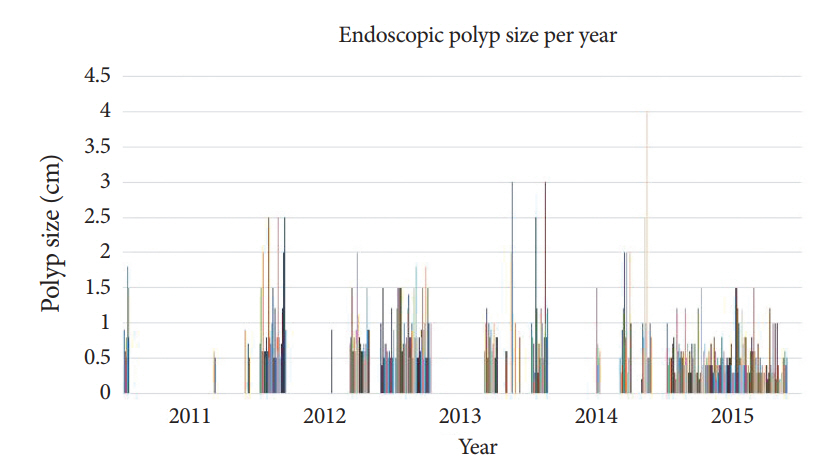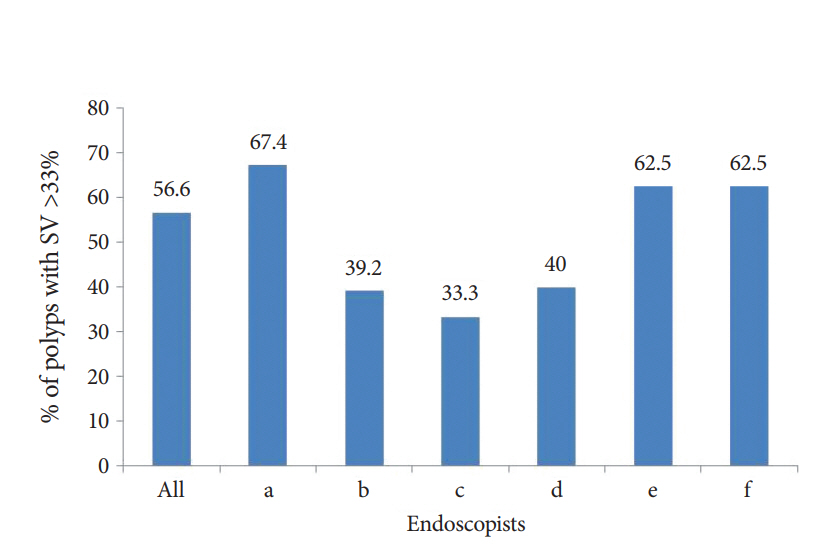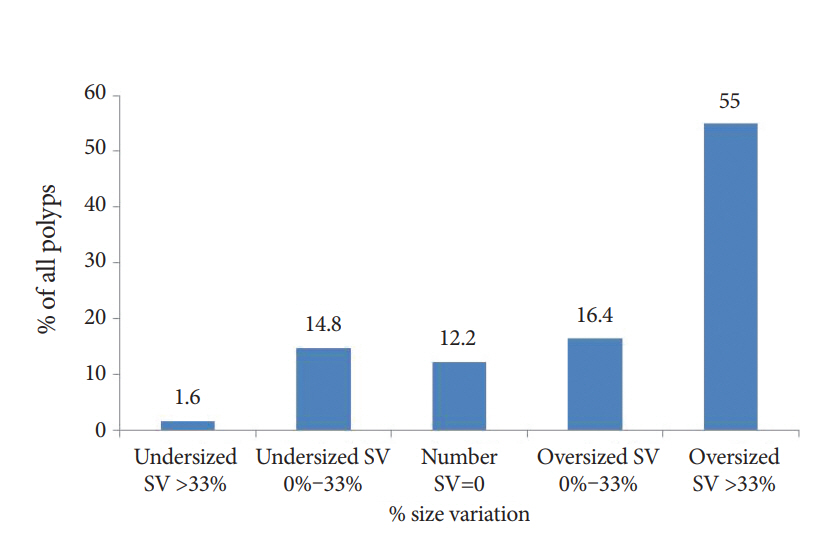Clin Endosc.
2018 Sep;51(5):485-490. 10.5946/ce.2017.183.
Mis-sizing of Adenomatous Polyps is Common among Endoscopists and Impacts Colorectal Cancer Screening Recommendations
- Affiliations
-
- 1Department of Medicine, University of Arizona Medical Center, Tucson, AZ, USA. staleban@yahoo.com
- 2Department of Molecular and Cellular Biology, University of Arizona, Tucson, AZ, USA.
- 3Department of Epidemiology and Biostatistics, Mel and Enid Zuckerman College of Public Health, University of Arizona, Tucson, AZ, USA.
- 4Division of Gastroenterology, Department of Medicine, University of Arizona Medical Center, Tucson, AZ, USA.
- KMID: 2427722
- DOI: http://doi.org/10.5946/ce.2017.183
Abstract
- BACKGROUND/AIMS
To determine the accuracy of identifying ≥6-mm adenomatous polyps during colonoscopy and define its impact on subsequent interval screening.
METHODS
We conducted a retrospective study of patients who underwent colonoscopies at Banner University Medical Center, Tucson from 2011 to 2015. All patients with ≥6-mm adenomatous polyps based on their colonoscopy report were included. Adenomatous polyps were excluded if they did not meet the criteria. Discrepancies in the polyp size were determined by calculating the percentage of size variation (SV). Clinical mis-sizing was defined as SV >33%.
RESULTS
The polyps analyzed were predominantly <10 mm in size. Approximately 13% of the examined polyps met the inclusion criteria, and 40.7% of the adenomas were ≥10 mm. A total of 189 ≥6-mm adenomatous polyps were collected from 10 different gastroenterologists and a colorectal surgeon. Adenomatous polyps were clinically mis-sized in 56.6% of cases and overestimated in 71.4%. Among the adenomas reviewed, 22% of mis-sized polyps and 11% of non-mis-sized polyps resulted in an inappropriate surveillance interval.
CONCLUSIONS
We found that more than half of ≥6-mm adenomatous polyps are mis-sized and that there is a tendency to overestimate adenoma size among endoscopists. This frequently leads to inappropriate intervals of surveillance colonoscopy.
Keyword
MeSH Terms
Figure
Cited by 1 articles
-
Importance of the Size of Adenomatous Polyps in Determining Appropriate Colonoscopic Surveillance Intervals
Hoon Sup Koo, Kyu Chan Huh
Clin Endosc. 2018;51(5):404-406. doi: 10.5946/ce.2018.139.
Reference
-
1. Lieberman DA, Rex DK, Winawer SJ, Giardiello FM, Johnson DA, Levin TR. Guidelines for colonoscopy surveillance after screening and polypectomy: a consensus update by the US multi-society task force on colorectal cancer. Gastroenterology. 2012; 143:844–857.
Article2. Tanaka S, Saitoh Y, Matsuda T, et al. Evidence-based clinical practice guidelines for management of colorectal polyps. J Gastroenterol. 2015; 50:252–260.
Article3. Matsuda T, Chiu HM, Sano Y, Fujii T, Ono A, Saito Y. Surveillance colonoscopy after endoscopic treatment for colorectal neoplasia: from the standpoint of the Asia-Pacific region. Dig Endosc. 2016; 28:342–347.
Article4. Winawer SJ, Zauber AG, Fletcher RH, et al. Guidelines for colonoscopy surveillance after polypectomy: a consensus update by the US multi-society task force on colorectal cancer and the American cancer society. CA Cancer J Clin. 2006; 56:143–159. quiz 184-185.
Article5. Schachschal G, Mayr M, Treszl A, et al. Endoscopic versus histological characterisation of polyps during screening colonoscopy. Gut. 2014; 63:458–465.
Article6. Eichenseer PJ, Dhanekula R, Jakate S, Mobarhan S, Melson JE. Endoscopic mis-sizing of polyps changes colorectal cancer surveillance recommendations. Dis Colon Rectum. 2013; 56:315–321.
Article7. Moug SJ, Vernall N, Saldanha J, McGregor JR, Balsitis M, Diament RH. Endoscopists’ estimation of size should not determine surveillance of colonic polyps. Colorectal Dis. 2010; 12:646–650.
Article8. Fennerty MB, Davidson J, Emerson SS, Sampliner RE, Hixson LJ, Garewal HS. Are endoscopic measurements of colonic polyps reliable? Am J Gastroenterol. 1993; 88:496–500.9. Margulies C, Krevsky B, Catalano MF. How accurate are endoscopic estimates of size? Gastrointest Endosc. 1994; 40(2 Pt 1):174–177.
Article10. Chaptini L, Chaaya A, Depalma F, Hunter K, Peikin S, Laine L. Variation in polyp size estimation among endoscopists and impact on surveillance intervals. Gastrointest Endosc. 2014; 80:652–659.
Article11. Pham T, Taleban S. Mis-sizing of polyps during colonoscopy does not impact colorectal cancer surveillance recommendations. In : American College of Gastroenterology (ACG) 2015 Annual Scientific Meeting and Postgraduate Course; 2015 Oct 16-21; Honolulu (HI), USA.12. Anderson BW, Smyrk TC, Anderson KS, et al. Endoscopic overestimation of colorectal polyp size. Gastrointest Endosc. 2016; 83:201–208.
Article13. Goede SL, Kuntz KM, van Ballegooijen M, et al. Cost-savings to medicare from pre-medicare colorectal cancer screening. Med Care. 2015; 53:630–638.
Article14. Centers for Disease Control and Prevetion. Colorectal Cancer Control Program (CRCCP) [Internet]. Atlanta (GA): Centers for Disease Control and Prevetion;c2017. [updated 2017 Aug 31; cited 2018 May 23]. Available from: https://www.cdc.gov/cancer/crccp/index.htm.15. The Paris endoscopic classification of superficial neoplastic lesions: esophagus, stomach, and colon: November 30 to December 1, 2002. Gastrointest Endosc. 2003; 58(6 Suppl):s3–s43.16. Gopalswamy N, Shenoy VN, Choudhry U, et al. Is in vivo measurement of size of polyps during colonoscopy accurate? Gastrointest Endosc. 1997; 46:497–502.
Article17. Kim JH, Park SJ, Lee JH, et al. Is forceps more useful than visualization for measurement of colon polyp size? World J Gastroenterol. 2016; 22:3220–3226.
Article18. Kume K, Watanabe T, Yoshikawa I, Harada M. Endoscopic measurement of polyp size using a novel calibrated hood. Gastroenterol Res Pract. 2014; 2014:714294.
Article19. Ashktorab H, Etaati F, Rezaeean F, et al. Can optical diagnosis of small colon polyps be accurate? Comparing standard scope without narrow banding to high definition scope with narrow banding. World J Gastroenterol. 2016; 22:6539–6546.
Article20. Summers RM. Polyp size measurement at CT colonography: what do we know and what do we need to know? Radiology. 2010; 255:707–720.
Article21. Pohl H, Srivastava A, Bensen SP, et al. Incomplete polyp resection during colonoscopy-results of the complete adenoma resection (CARE) study. Gastroenterology. 2013; 144:74–80.e1.
Article22. Obuch JC, Pigott CM, Ahnen DJ. Sessile serrated polyps: detection, eradication, and prevention of the evil twin. Curr Treat Options Gastroenterol. 2015; 13:156–170.
Article23. Schoen RE, Gerber LD, Margulies C. The pathologic measurement of polyp size is preferable to the endoscopic estimate. Gastrointest Endosc. 1997; 46:492–496.
Article24. Levene Y, Hutchinson JM, Tinkler-Hundal E, Quirke P, West NP. The correlation between endoscopic and histopathological measurements in colorectal polyps. Histopathology. 2015; 66:485–490.
Article25. Morales TG, Sampliner RE, Garewal HS, Fennerty MB, Aickin M. The difference in colon polyp size before and after removal. Gastrointest Endosc. 1996; 43:25–28.
Article26. Hofstad B, Vatn M, Larsen S, Osnes M. Reliability of in situ measurements of colorectal polyps. Scand J Gastroenterol. 1992; 27:59–64.
Article27. Hofstad B, Vatn M, Larsen S, Huitfeldt HS, Osnes M. In situ measurement of colorectal polyps to compare video and fiberoptic endoscopes. Endoscopy. 1994; 26:461–465.
Article
- Full Text Links
- Actions
-
Cited
- CITED
-
- Close
- Share
- Similar articles
-
- Risk of Adenomatous Polyps in the Proximal Colon according to Age and Gender
- Early Detection of and Screening for Colorectal Neoplasia
- Polyp Detection, Characterization, and Management Using Narrow-Band Imaging with/without Magnification
- Clinical Observation of Colorectal Polyps
- Optimal Colonoscopy Surveillance Interval after Polypectomy





